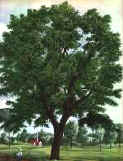Pecan
The pecans and hickories which make up the Carya genus have as treasured a place in the history of America as they do on the American palate. This family of large, widely distributed trees is generally known for its graceful trunk, rounded, spreading crown, rough or even shaggy bark, its long leaves, and for its delicious nut meat. Pecans and hickories have not only served generations of Americans with their welcome shade, but they have also given their distinctive flavor to many uniquely American dishes. Their wood has warmed many a hearth and been fashioned into some of our finest furniture and most vital utensils and implements.
The Pecan’s Place in History
Few trees have a more colorful American history than the pecan—a tree that was described by Western explorers as early as 1541, when Hernando De Soto and his band of gold seekers came upon it. The tree went on to earn acclaim from the earliest settlers of French Louisiana, when they learned of the high regard Native Americans held for the pecan’s delicious nut meat, as well as for the dyes and oils made from parts of the tree. The pecan was soon a part of the cooking and culture of the French pioneers and others, a tradition that continues today and makes the pecan a prized tree. Today as in the past, the wood of the pecan is valued for the tremendous heat it produces when burned and for its great strength and toughness. Thomas Jefferson admired the pecan enough to plant nuts at Monticello and to send seeds to George Washington, who planted and cared for his own pecans. Today those pecans have the distinction of being the oldest living trees at Mount Vernon.
Some Common Species
The tree popularly referred to as the pecan (Carya illinoensis) not only grows in the wild from Iowa to Indiana and to Alabama and Texas, but also thrives in commercial orchards. So desirable is pecan nut meat that it is a leading horticultural crop in the Southeast and Southwest. The pecan makes an admirable shade tree as well, growing to 100 feet or more in height with a similar spread. Its wonderfully strong and hard wood is used for making furniture, veneer, molding, plywood, and skis. (Grows in hardiness zones 5 to 9.)
Shagbark hickory (Carya ovata) is a large tree, which can grow to 100 feet or more with a tall, straight trunk and oblong crown, covered in attractive summer leaves of yellow-green, changing to a rich yellow-gold in fall. The wood of this hickory has a higher fuel value than any tree in America except the locust. It takes its colorful name from its gray-brown bark, which warps away from the trunk in long plates that connect at the edges. Among the best-loved uses of its wood is the preparation of some of America’s famous smoke-cured hams. Shagbark hickory grows naturally from the northeastern United States southward to Texas. (Grows in hardiness zones 4 to 8.)


